Copper Staff
Contributors from members of the Copper team
Business cards used to be the go-to for making connections at conferences, networking events, or trade shows.
But in a world where many of us work from home or meet virtually, the once-iconic 3.5 x 2-inch rectangle has lost its edge.
Still, networking isn’t going anywhere—and neither is the need to make a lasting impression. That’s where a great business card alternative comes in. Whether you're attending in person or connecting digitally, your contact info should be easy to share, memorable, and ideally, not something that ends up in the recycling bin.
Of course if you don't want to lose your business cards, we have a scanner for that (but more on that later!).
So, in order to separate yourself from the competition, you need to think even more outside the box. Here are seven business card alternatives that’ll make you easier to remember and increase your chances of hearing back from prospects when the event is over:
1. Edible business cards
Let’s be honest: snacks are the real MVP of any event. So why not turn that sweet treat into your next connection? From cookies with your logo to chocolate bars with a QR code printed on the wrapper, edible goodies are a fun, delicious, and effective business card alternative.
You could be a creative agency handing out artisanal chocolate squares, each wrapped in a beautifully designed sleeve that links directly to your latest portfolio. Or you’re a video production company with popcorn bags labeled with a QR code to your sizzle reel. Your card doesn’t just get noticed—it gets devoured (in the best way).
These edible touchpoints are especially perfect for brands in food, lifestyle, events, or just about anyone who wants to leave a lasting (and tasty) impression.
They also show off your creativity and generosity. Instead of handing someone a piece of paper they may toss, you’re giving them something they’ll genuinely enjoy—which creates positive brand association and a moment they’ll remember.
Just make sure your contact info is on the packaging—because while they’ll definitely remember the flavor, they’ll need help remembering your name
2. Functional business cards
Make it useful, not just memorable! Give your business card a purpose, and it’s more likely to stick around. Think bottle openers, mini rulers, or matchboxes that come with your contact details subtly etched or printed on them.

Let’s say you run a branding consultancy. You could hand out metal cards that double as phone stands. A marketing consultant might offer microfiber lens cloths with their contact info printed on the pouch—a subtle but appreciated tool for people constantly on their screens.
Even simple items like sticker sheets, bookmarks, or notepads with witty copy can add value and reinforce your brand personality.
Or another great example from hair and makeup artist, Yuka Suzuki, is one very on-brand idea: business cards that have hairpins attached to them.
If you're looking for a business card alternative that has staying power, this category is full of practical winners.

Try to include a tool or item that connects with the problem that your products or services can solve. That way, when a prospect goes to use your functional business card, you’ll be top of mind.
3. NFC-enabled smart business cards
Paper is out, tapping is in. NFC (Near Field Communication) cards are sleek, smart, and completely reusable. With a single tap of your phone, your contact info, website, LinkedIn, and even booking link can pop up instantly.
These are perfect for consultants, creators, or media pros who are always on the move. No printing. No fumbling. Just one card that works forever—and looks seriously cool.
Plus, you can update the destination anytime. Doing a big product launch or campaign refresh? Just tweak the link. Tools like TapTag, Mobilo, and Linq make it easy to stay on-brand and on-trend.
This isn’t just a modern business card alternative—it’s a power move.
4. Add a personalized QR code swag
Make your merch do the talking! Maybe you’ve got tote bags, mugs, or stickers—now, make them work for you.
QR code swag is the perfect mix of fun and function. A content strategist could design laptop decals with a scan-to-connect feature. A podcaster might print coffee sleeves with QR codes that open the latest episode. An agency could hand out branded notebooks that double as portfolio launchpads.
It’s practical. It’s trackable. And most importantly? It’s memorable.
Turn everyday merch into a business card alternative people actually want to keep—and scan again.
5. Sustainable and plantable business cards
Looking for an eco-conscious and genuinely memorable way to connect? Plantable business cards might be your new best friend. These cards are printed on seed paper—so once your prospect is done reading it, they can plant it and watch it bloom.
Whether it’s wildflowers, herbs, or leafy greens, you’re not just handing out your name—you’re offering a physical, living reminder of your brand.

A wellness coach could hand out lavender-seed cards. A sustainability-focused creative agency might opt for basil or wildflower seed paper. Even event planners and lifestyle influencers have started using these to align with their values and leave a meaningful impression.
This unique business card alternative isn’t just eco-friendly—it’s symbolic. Because what better metaphor for a new relationship than something that grows?
6. Digital business cards
Let’s face it—paper gets lost, but links live forever. Digital business cards are perfect for modern professionals who want to be found fast.
With apps like HiHello and Blinq, you can customize your digital card to include your contact info, social links, recent projects, and more—all shareable with a single tap or scan.
Imagine being at a media summit and sending your portfolio, podcast, and press kit to someone’s phone in two seconds. Boom. Done. This is a business card alternative built for speed and scale.
Plus, digital cards can be saved in Apple or Google Wallets, making future follow-ups a breeze.
7. CRM – an alternative to business cards
Sometimes getting creative with your business card isn’t enough to truly stand out. If you’re at an event where you know prospects will be collecting tons of cards from other vendors, you may want to skip handing them out altogether.
However, that doesn’t mean you should let prospects go without any connection. Instead, you can use your CRM to collect their contact information and take control of the conversation.
Inputting contact information straight into your CRM makes sure that nothing gets lost. When you add a prospect’s name, number, and email, you can also leave notes to remind yourself about the details of the conversation later.
A CRM like Copper puts customer information directly into your email inbox—allowing for quick and easy communication.
Using a CRM gives your team the ability to pool information on prospects and see if you’re talking to the same person. If you’re able to compile sales notes in real time, you can learn more about prospects while they’re right in front of you and use that information to send more targeted follow-ups when you’re back in the office.
One of the biggest perks of having all this prospect information is that it gives you the ability to take initiative and reach out. Unlike with exchanging business cards, you don’t need to worry about a prospect choosing to get in touch. Add them straight into your CRM to automatically set the next conversation in motion.
Even better? Copper's Business Card Scanner makes capturing new contacts effortless. Just snap a photo of any card, and the contact details get pulled directly into your CRM—no manual entry, no follow-up delays, and no more lost connections.
This is a modern business card alternative for anyone tired of collecting stacks of paper or missing follow-ups.

FREE GUIDE
More on CRM? 👇
Curious about all the little-known ways a CRM can be used? Grab the free guide to getting the most out of your CRM.
How do you choose the right business card alternative?
The traditional business card isn’t completely dead—yet. But it’s definitely due for an upgrade.
You can still carry a few classic cards for those who ask, but having a more creative or tech-forward option can help you stand out when the competition is high.
To choose the right business card alternative for your brand, think about what you do and who your audience is. Can you offer a sample, a useful tool, or a memorable moment that connects back to your work?
The more creative you are, the more memorable your connections will be. And if you’re using Copper? Don’t just stand out—follow up faster, smarter, and without the chaos of paper piles.
Try Copper for free and see how easy it is to never lose a contact again.










